Abstract
Presentation of linear epitopes of the B19 parvovirus capsid proteins as peptides might be a useful vaccine strategy. We produced overlapping fusion proteins to span the viral capsid sequence, inoculated rabbits, and determined whether the resulting antisera contained antibodies that neutralized the ability of the virus to infect human erythroid progenitor cells. Antibodies that bound to virus in an enzyme-linked immunosorbent assay were present in antisera raised against 10 of 11 peptides; strongest activity was found for antisera against the carboxyl-terminal half of the major capsid protein. However, strong neutralizing activity was elicited in animals immunized with peptides from the amino-terminal portion of the unique region of the minor capsid protein and peptides containing the sequence of the junction region between the minor and major capsid proteins. The development of neutralizing activity in animals was elicited most rapidly with the fusion peptide from the first quarter of the unique region. A 20-amino-acid region of the unique region of the minor capsid protein was shown to contain a neutralizing epitope. Multiple antigenic peptides, based on the sequence of the unique region and produced by covalent linkage through a polylysine backbone, elicited strong neutralizing antibody responses. Synthetic peptides and fusion proteins containing small regions of the unique portion of the minor capsid protein might be useful as immunogens in a human vaccine against B19 parvovirus.
Full text
PDF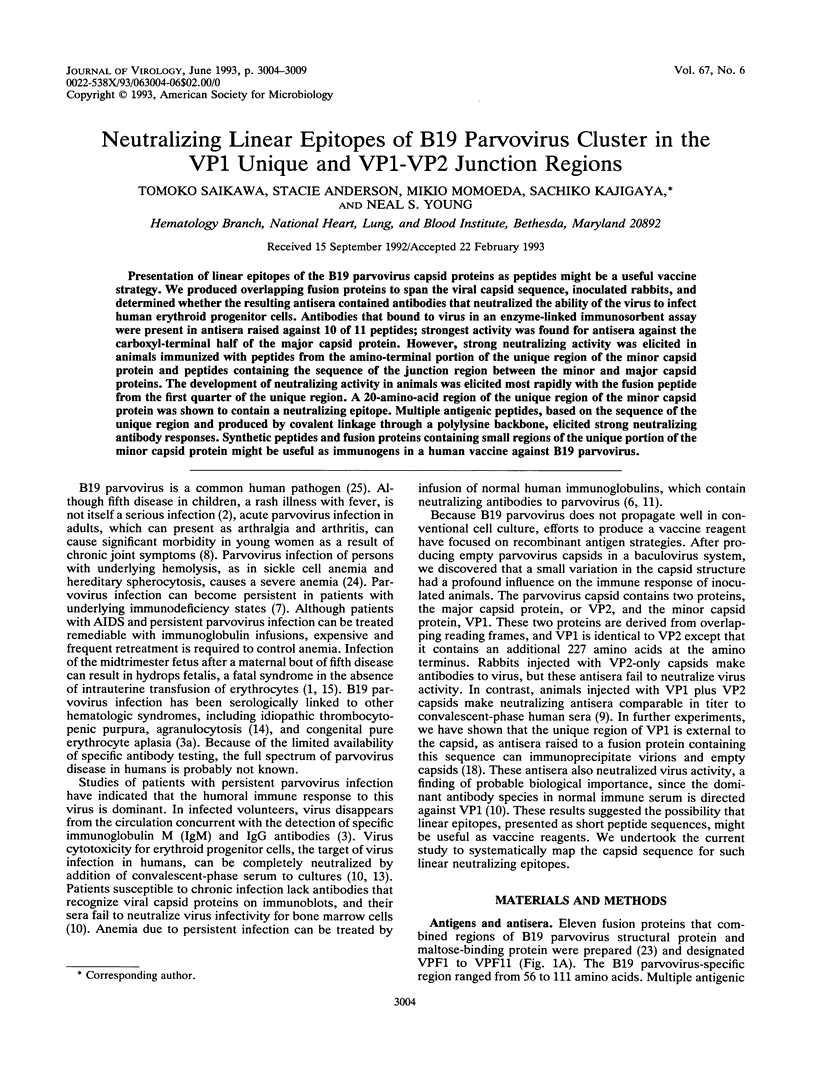
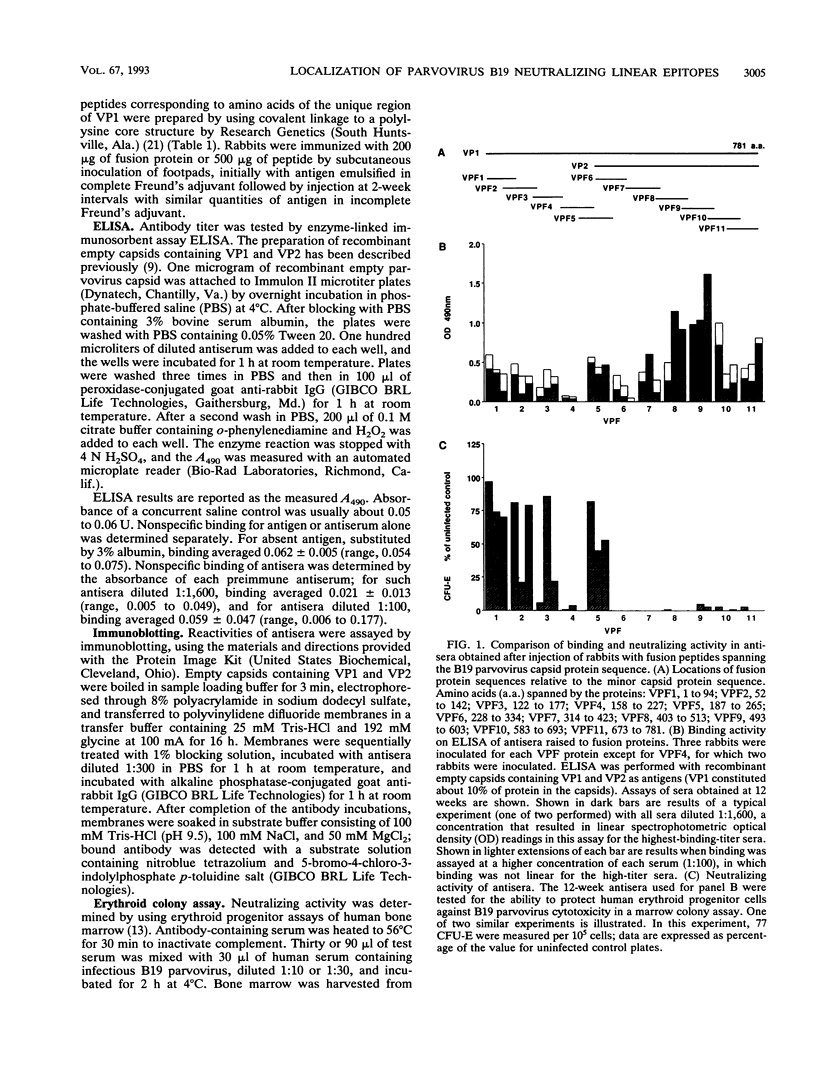
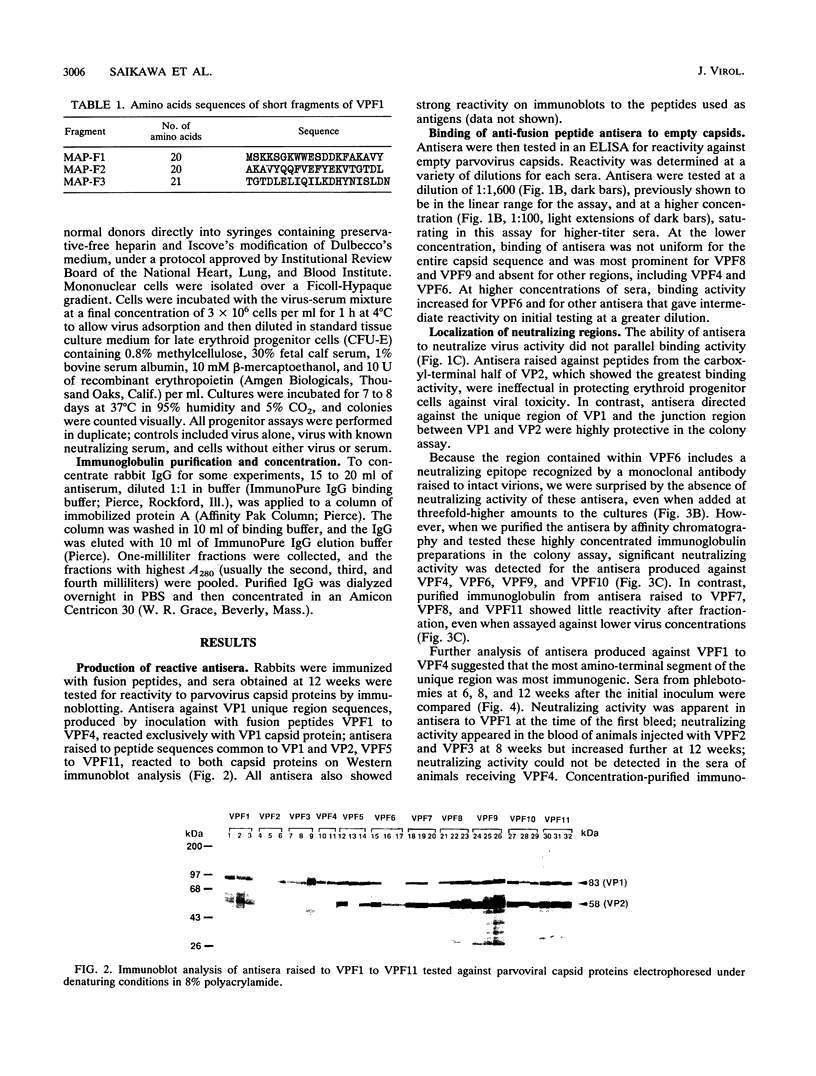
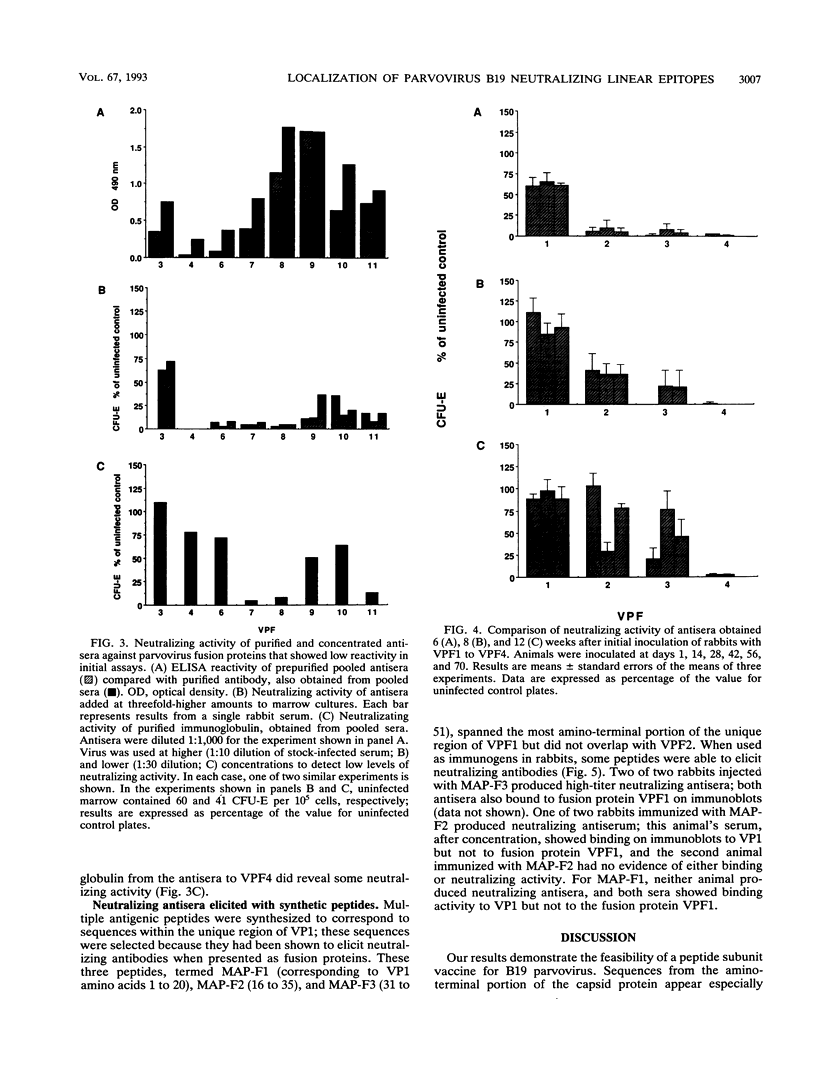
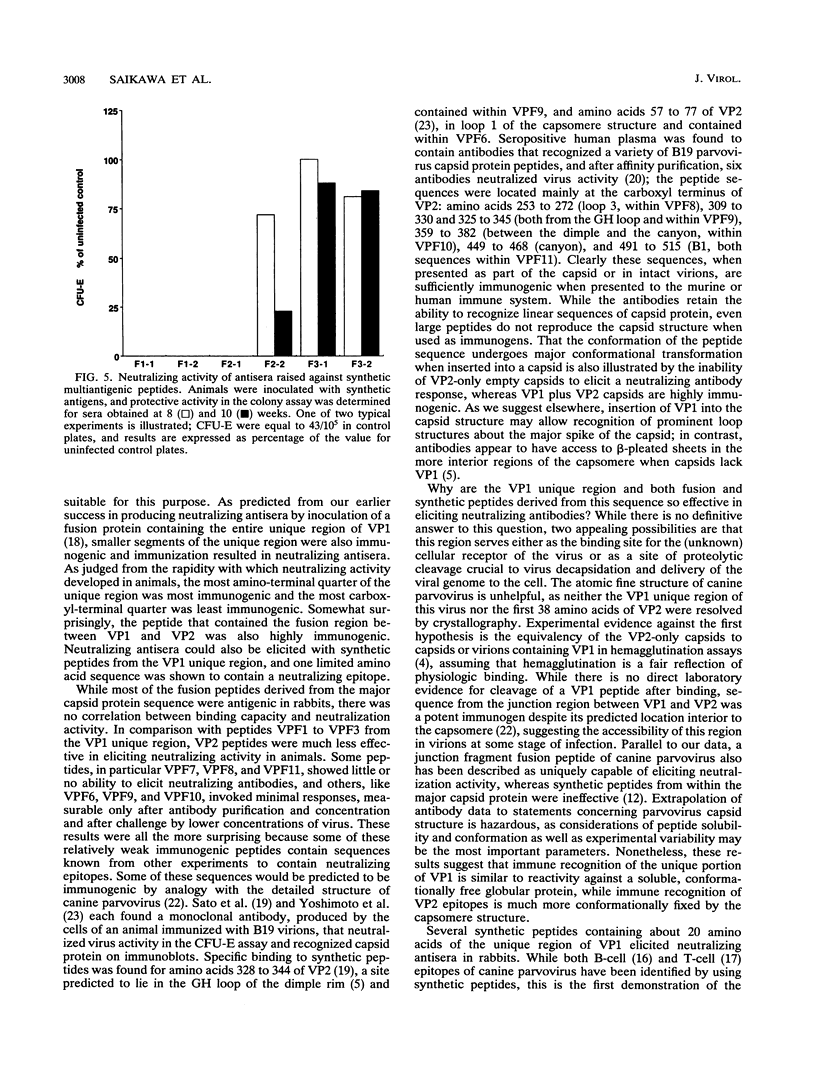
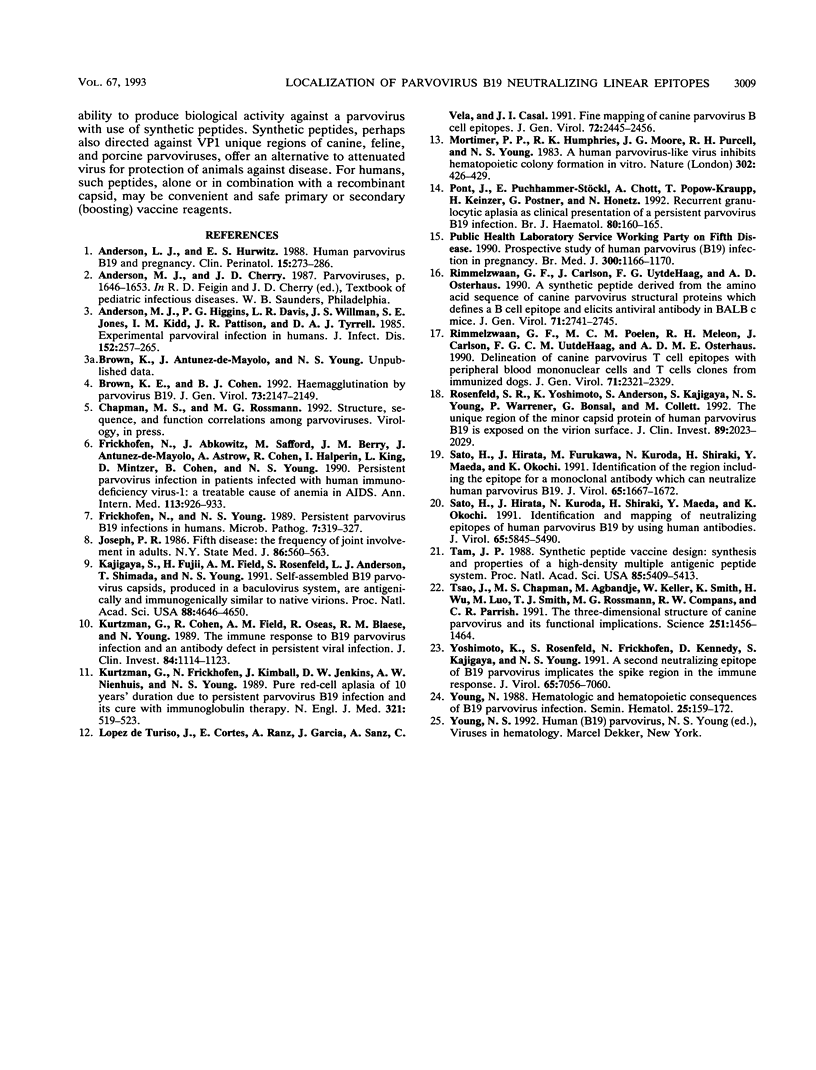
Images in this article
Selected References
These references are in PubMed. This may not be the complete list of references from this article.
- Anderson L. J., Hurwitz E. S. Human parvovirus B19 and pregnancy. Clin Perinatol. 1988 Jun;15(2):273–286. [PubMed] [Google Scholar]
- Anderson M. J., Higgins P. G., Davis L. R., Willman J. S., Jones S. E., Kidd I. M., Pattison J. R., Tyrrell D. A. Experimental parvoviral infection in humans. J Infect Dis. 1985 Aug;152(2):257–265. doi: 10.1093/infdis/152.2.257. [DOI] [PubMed] [Google Scholar]
- Brown K. E., Cohen B. J. Haemagglutination by parvovirus B19. J Gen Virol. 1992 Aug;73(Pt 8):2147–2149. doi: 10.1099/0022-1317-73-8-2147. [DOI] [PubMed] [Google Scholar]
- Frickhofen N., Abkowitz J. L., Safford M., Berry J. M., Antunez-de-Mayolo J., Astrow A., Cohen R., Halperin I., King L., Mintzer D. Persistent B19 parvovirus infection in patients infected with human immunodeficiency virus type 1 (HIV-1): a treatable cause of anemia in AIDS. Ann Intern Med. 1990 Dec 15;113(12):926–933. doi: 10.7326/0003-4819-113-12-926. [DOI] [PubMed] [Google Scholar]
- Frickhofen N., Young N. S. Persistent parvovirus B19 infections in humans. Microb Pathog. 1989 Nov;7(5):319–327. doi: 10.1016/0882-4010(89)90035-1. [DOI] [PubMed] [Google Scholar]
- Joseph P. R. Fifth disease: the frequency of joint involvement in adults. N Y State J Med. 1986 Nov;86(11):560–563. [PubMed] [Google Scholar]
- Kajigaya S., Fujii H., Field A., Anderson S., Rosenfeld S., Anderson L. J., Shimada T., Young N. S. Self-assembled B19 parvovirus capsids, produced in a baculovirus system, are antigenically and immunogenically similar to native virions. Proc Natl Acad Sci U S A. 1991 Jun 1;88(11):4646–4650. doi: 10.1073/pnas.88.11.4646. [DOI] [PMC free article] [PubMed] [Google Scholar]
- Kurtzman G. J., Cohen B. J., Field A. M., Oseas R., Blaese R. M., Young N. S. Immune response to B19 parvovirus and an antibody defect in persistent viral infection. J Clin Invest. 1989 Oct;84(4):1114–1123. doi: 10.1172/JCI114274. [DOI] [PMC free article] [PubMed] [Google Scholar]
- Kurtzman G., Frickhofen N., Kimball J., Jenkins D. W., Nienhuis A. W., Young N. S. Pure red-cell aplasia of 10 years' duration due to persistent parvovirus B19 infection and its cure with immunoglobulin therapy. N Engl J Med. 1989 Aug 24;321(8):519–523. doi: 10.1056/NEJM198908243210807. [DOI] [PubMed] [Google Scholar]
- López de Turiso J. A., Cortés E., Ranz A., García J., Sanz A., Vela C., Casal J. I. Fine mapping of canine parvovirus B cell epitopes. J Gen Virol. 1991 Oct;72(Pt 10):2445–2456. doi: 10.1099/0022-1317-72-10-2445. [DOI] [PubMed] [Google Scholar]
- Mortimer P. P., Humphries R. K., Moore J. G., Purcell R. H., Young N. S. A human parvovirus-like virus inhibits haematopoietic colony formation in vitro. 1983 Mar 31-Apr 6Nature. 302(5907):426–429. doi: 10.1038/302426a0. [DOI] [PubMed] [Google Scholar]
- Pont J., Puchhammer-Stöckl E., Chott A., Popow-Kraupp T., Kienzer H., Postner G., Honetz N. Recurrent granulocytic aplasia as clinical presentation of a persistent parvovirus B19 infection. Br J Haematol. 1992 Feb;80(2):160–165. doi: 10.1111/j.1365-2141.1992.tb08894.x. [DOI] [PubMed] [Google Scholar]
- Rimmelzwaan G. F., Carlson J., UytdeHaag F. G., Osterhaus A. D. A synthetic peptide derived from the amino acid sequence of canine parvovirus structural proteins which defines a B cell epitope and elicits antiviral antibody in BALB c mice. J Gen Virol. 1990 Nov;71(Pt 11):2741–2745. doi: 10.1099/0022-1317-71-11-2741. [DOI] [PubMed] [Google Scholar]
- Rimmelzwaan G. F., Poelen M. C., Meloen R. H., Carlson J., UytdeHaag F. G., Osterhaus A. D. Delineation of canine parvovirus T cell epitopes with peripheral blood mononuclear cells and T cell clones from immunized dogs. J Gen Virol. 1990 Oct;71(Pt 10):2321–2329. doi: 10.1099/0022-1317-71-10-2321. [DOI] [PubMed] [Google Scholar]
- Rosenfeld S. J., Yoshimoto K., Kajigaya S., Anderson S., Young N. S., Field A., Warrener P., Bansal G., Collett M. S. Unique region of the minor capsid protein of human parvovirus B19 is exposed on the virion surface. J Clin Invest. 1992 Jun;89(6):2023–2029. doi: 10.1172/JCI115812. [DOI] [PMC free article] [PubMed] [Google Scholar]
- Sato H., Hirata J., Furukawa M., Kuroda N., Shiraki H., Maeda Y., Okochi K. Identification of the region including the epitope for a monoclonal antibody which can neutralize human parvovirus B19. J Virol. 1991 Apr;65(4):1667–1672. doi: 10.1128/jvi.65.4.1667-1672.1991. [DOI] [PMC free article] [PubMed] [Google Scholar]
- Sato H., Hirata J., Kuroda N., Shiraki H., Maeda Y., Okochi K. Identification and mapping of neutralizing epitopes of human parvovirus B19 by using human antibodies. J Virol. 1991 Oct;65(10):5485–5490. doi: 10.1128/jvi.65.10.5485-5490.1991. [DOI] [PMC free article] [PubMed] [Google Scholar]
- Tam J. P. Synthetic peptide vaccine design: synthesis and properties of a high-density multiple antigenic peptide system. Proc Natl Acad Sci U S A. 1988 Aug;85(15):5409–5413. doi: 10.1073/pnas.85.15.5409. [DOI] [PMC free article] [PubMed] [Google Scholar]
- Tsao J., Chapman M. S., Agbandje M., Keller W., Smith K., Wu H., Luo M., Smith T. J., Rossmann M. G., Compans R. W. The three-dimensional structure of canine parvovirus and its functional implications. Science. 1991 Mar 22;251(5000):1456–1464. doi: 10.1126/science.2006420. [DOI] [PubMed] [Google Scholar]
- Yoshimoto K., Rosenfeld S., Frickhofen N., Kennedy D., Hills R., Kajigaya S., Young N. S. A second neutralizing epitope of B19 parvovirus implicates the spike region in the immune response. J Virol. 1991 Dec;65(12):7056–7060. doi: 10.1128/jvi.65.12.7056-7060.1991. [DOI] [PMC free article] [PubMed] [Google Scholar]
- Young N. Hematologic and hematopoietic consequences of B19 parvovirus infection. Semin Hematol. 1988 Apr;25(2):159–172. [PubMed] [Google Scholar]



